PRINCETON, NJ -- Gallup's Net New Hiring Activity measure shows that U.S. workers' perceptions of the job market at their places of employment -- already down significantly in August -- became much worse in September.
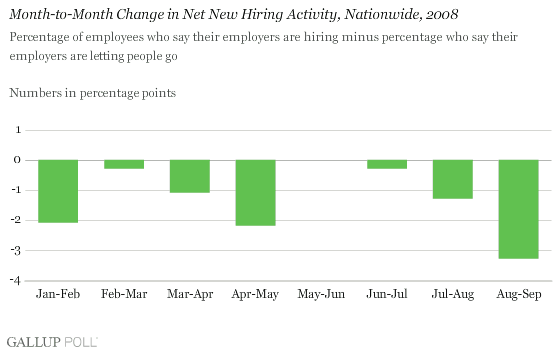
Job Losses Reaching Crisis Proportions
With the presidential election weeks away, the financial crisis and the Treasury bailout are dominating the headlines. Still, once Congress acts to shore up the U.S. banking system, the focus of most Americans may immediately turn to the Main Street economy and the accelerating pace of job losses taking place across the nation -- something the financial crisis has only made worse during recent weeks.
Gallup's Net New Hiring Activity measure, based on interviews with more than 9,000 employees in September, suggests the jobs situation that worsened significantly during August deteriorated even more significantly during September. The percentage of employees saying their companies are hiring fell to 34.8%, the lowest level of the year, while the percentage saying their companies are letting people go increased to 19.2% -- the highest.
In turn, this suggests that the number of jobs not only declined again in September (for the ninth consecutive month), but probably did so by substantially more than the 100,000 jobs decline generally expected. More importantly, the unemployment rate may actually surge past last month's 6.1%. A number of variables make it hard to predict exactly what job numbers the Bureau of Labor Statistics will report on Friday morning. Regardless, these Gallup jobs findings suggest the next crisis facing the American people -- and just possibly the key issue of the last few weeks before the election -- may be jobs.
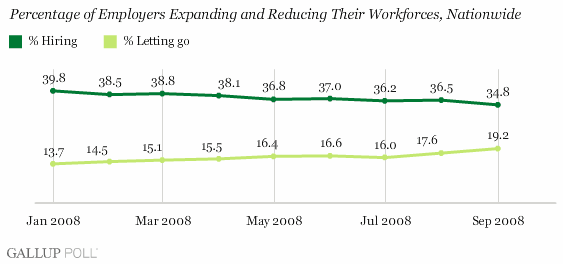
Net New Hiring Activity by Region
Net new hiring activity fell in all regions in September, with the sharpest declines taking place in the Midwest and East. Still, the South and the West also experienced substantial declines. Job-market perceptions remain best in the South and are worst in the Midwest.
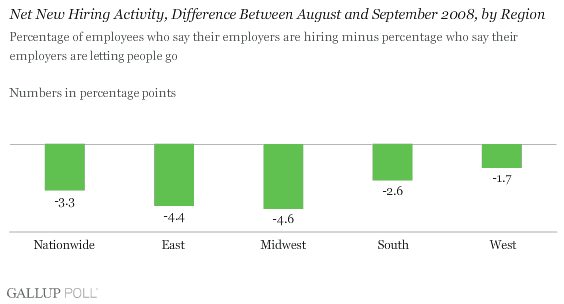
Even before the fallout of recent weeks, it was clear that the East is suffering economically from the continuing financial crisis. In September, Gallup's Net New Hiring Activity measure began to pick up more of this fallout, but unfortunately, all of the impact of the current financial debacle has yet to be fully realized. Job-market conditions in the East are better only than those in the Midwest right now, and this may not be the case for long.
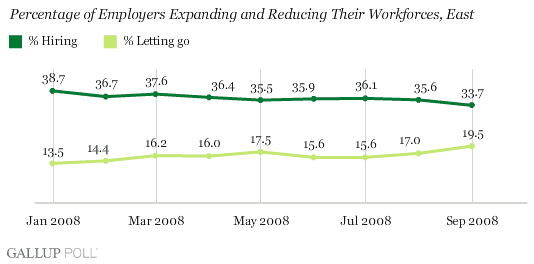
Despite all the talk that the exporting business in the United States has remained strong, net new hiring activity in the Midwest also plunged in September. Given that overseas economies are slowing, it seems likely that Midwest job-market conditions are likely to deteriorate further in the months ahead.
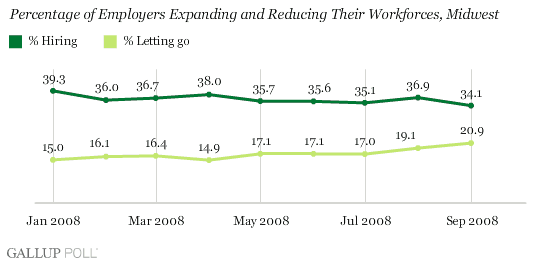
Net new hiring activity also continued to decline in the South in September, but less than the declines that took place in the East and Midwest. Even after its August and September drops in net new hiring activity, the South continues to have the best job market of any region.
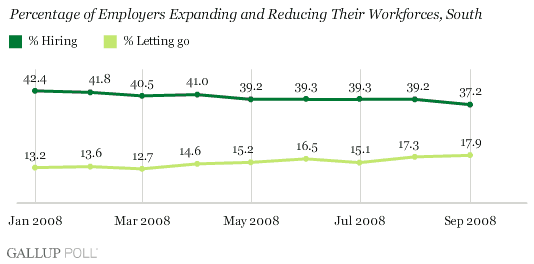
Net new hiring activity also declined in the West in September, although relatively less than in other regions. Job-market conditions in the West are closer to those in the East and Midwest than to those in the South.
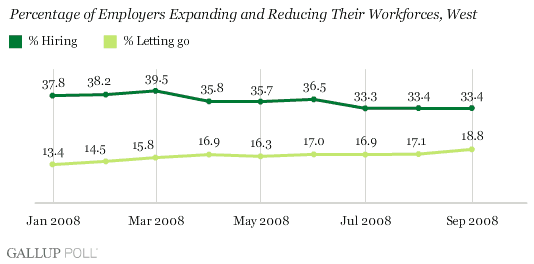
Jobs Crisis
While everyone's attention is focused on the financial crisis, the Main Street economy is deteriorating rapidly. Gallup's consumer confidence measures show a sharp decline beginning in mid-September. Add in the accelerating decline in job-market conditions and the further tightening of consumer credit, together with the fear created by debate surrounding the Treasury's "rescue" plan, and consumer perceptions are likely to continue plummeting in the weeks ahead.
The coming elections are not likely to help. Each political party is likely to try to escape blame for the economic policies of the past and to blame the other party instead. But the decline of the jobs market and the deepening recession on Main Street may have many Americans looking for solutions to the deepening economic downturn -- not just a villain to blame. Providing those solutions and turning around the increasing pessimism among consumers may be the key to winning for the presidential candidates in the few weeks remaining before the election.
Survey Methods
Gallup's Net New Hiring Activity measure was initiated in January 2008. It is an effort to assess U.S. job creation or elimination based on the self-reports of more than 8,000 individual employees each month about hiring and firing activity at their workplaces. In order to calculate this measure, Gallup asks current full-time employees whether their employers are hiring new people and expanding the size of their workforces, not changing the size of their workforces, or letting people go and reducing the size of their workforces. Net new hiring activity is computed by subtracting the "letting go and reducing" percentage from the "hiring and expanding" percentage. The assumption is that employees across the country have a good feel for what's happening in their companies, and that these insider perceptions can yield a useful summary indication of the nation's job situation.
Gallup is interviewing no fewer than 1,000 U.S. adults nationwide each day during 2008. The economic questions analyzed in this report are asked of a random half-sample of respondents each day. The results reported here are based on combined data of more than 8,000 interviews in each month, January through September. For results based on these samples, the maximum margin of sampling error is ±1 percentage point.
Interviews are conducted with respondents on land-line telephones (for respondents with a land-line telephone) and cellular phones (for respondents who are cell-phone only).
In addition to sampling error, question wording and practical difficulties in conducting surveys can introduce error or bias into the findings of public opinion polls.

